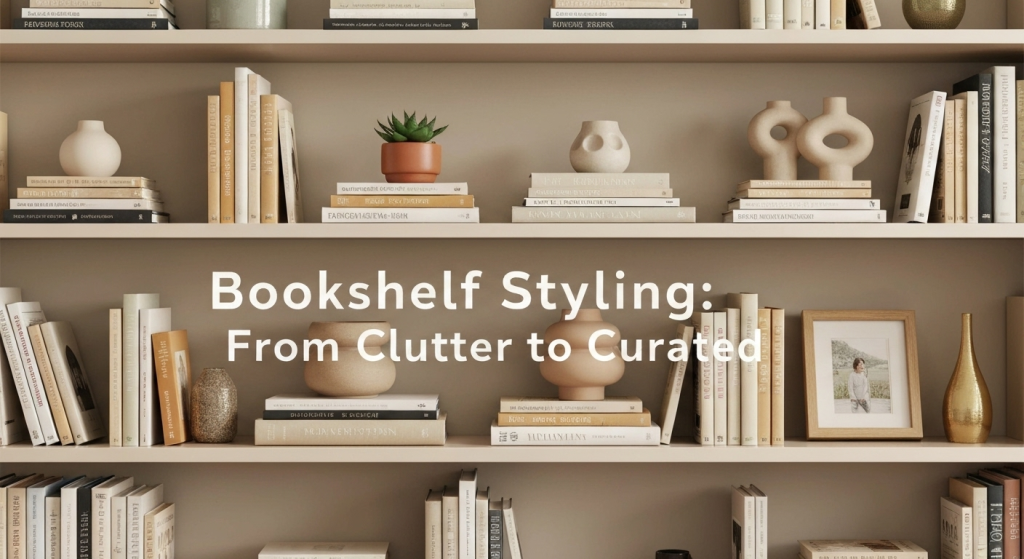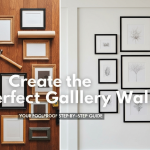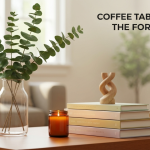A bookshelf is so much more than a piece of furniture for storage. It’s a backdrop to your life, a collection of stories, and a reflection of your personality. But let’s be honest, it can quickly turn into a cluttered, overflowing mess that adds stress rather than style to a room. If you’re looking down at piles of books crammed onto bowing shelves, wondering how anyone achieves that polished, magazine-worthy look, you’re in the right place. Styling a bookshelf isn’t about rigid rules; it’s about learning a few simple design principles to create balance, harmony, and function.
My name is William Johnson, and I’ve been exploring and writing about the world of home decor for years. For the past five years, much of my work has revolved around helping people find that perfect balance where everyday items become a beautiful part of their home’s story. I’ve learned, through countless client projects and my own trial and error, that a bookshelf is one of the most powerful storytelling tools in a room. It’s not about buying new things, but about thoughtfully arranging what you already own. My goal here is to share those practical, hands-on lessons with you, so you can transform that cluttered shelf into a display you’re genuinely proud of.
The First, Crucial Step: The Great Shelf Edit
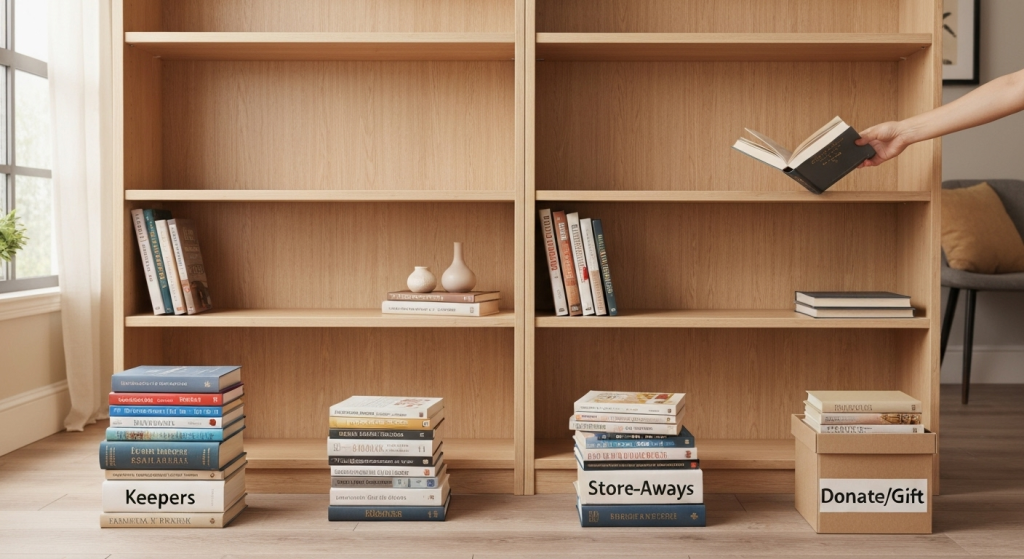
Before you can style, you must simplify. You cannot organize clutter. The most stunning bookshelf arrangements begin not with adding things, but with taking almost everything away. This step feels like a chore, but I promise it’s the most impactful part of the process.
Start by completely emptying your bookshelf. Every book, every photo frame, every little trinket. Wipe the shelves down and give yourself a truly blank canvas. This forces you to see the space with fresh eyes and evaluate each item individually.
Now, create three piles for your books and objects:
- The Keepers: These are the books you love, the ones you reference often, or the ones with beautiful covers that bring you joy. For decorative objects, these are the pieces that have meaning or fit the aesthetic you’re aiming for.
- The Store-Aways: This pile is for books you want to keep but don’t need immediate access to. Think of paperbacks you’ve already read or old textbooks. These can be stored in bins under a bed or in a closet. The same goes for sentimental objects that don’t quite fit the new look but you can’t part with.
- The Donate/Gift Pile: Be honest with yourself. Will you ever reread that novel you didn’t love? Are you holding onto a decorative vase that was a gift but has never been your style? Let these items go. Freeing up this physical and visual space is liberating.
Once you have your edited “Keepers” collection, you have the curated ingredients to start building your beautifully styled shelf.
Mastering the Art of Book Arrangement
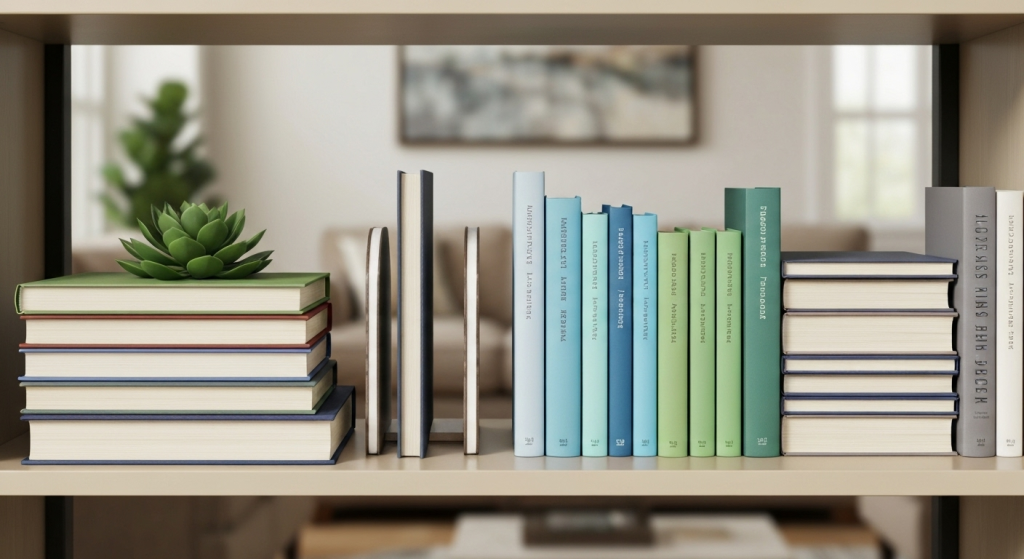
With your curated collection of books, it’s time to place them back on the shelves with intention. How you arrange your books forms the foundation of the entire look. Forget just lining them up—we’re creating visual interest.
Vertical vs. Horizontal: Creating Rhythm and Flow
The simplest way to break up the monotony of a shelf is by varying the orientation of your books. Mixing vertical rows with horizontal stacks creates instant rhythm and provides little platforms for decorative objects.
- Vertical Rows: This is the traditional way we store books. It’s practical, easy to read the spines, and works perfectly for the bulk of your collection. Keep these rows tidy and push the books back so the spines are aligned.
- Horizontal Stacks: Stacking 3-5 books horizontally creates a visual pause. It breaks up long lines of vertical spines and adds a sculptural element. I often use a stack of visually interesting books as a “bookend” to hold up a vertical row. It also provides a perfect perch for a small plant or a decorative bowl.
Here’s a quick breakdown of when to use each approach:
| Orientation | Best For | Pro Tip |
| Vertical | The majority of your books, especially paperbacks and books in a series. | Keep the spines aligned for a clean, library-like look. Avoid leaning books. |
| Horizontal | Hardcover books with nice spines, visually interesting coffee table books. | Use stacks of 3 or 5 (odd numbers are visually more appealing). The largest book should be on the bottom. |
The Great Color Debate: To Rainbow or Not to Rainbow?
Arranging books by color can be visually stunning. It creates a bold, graphic statement that turns your bookshelf into a piece of art. However, it’s not for everyone. The biggest drawback is functionality; if you organize your books by author or subject, finding a specific title can become a treasure hunt.
Here’s how I approach it to get the best of both worlds:
- Go All In (For the Bold): If your bookshelf is purely for aesthetics and you don’t need to find books quickly, a full rainbow arrangement can be spectacular.
- The Balanced Approach: This is my preferred method. Group your books by subject or genre first (e.g., fiction, history, cookbooks). Then, within each of those sections, arrange the books in a pleasing color flow. This gives you a subtle, sophisticated color story without sacrificing the ability to find what you’re looking for.
- Neutral Palette: If you prefer a calmer look, try grouping all of your books with white, black, and grey spines together. This creates a serene, minimalist feel and makes any colorful decorative objects you add really pop.
Thinking Beyond Color: Grouping by Size and Theme
If color-coding isn’t your thing, arranging books by size can create a very calming and orderly effect. Start by placing the tallest books on the outer edges of a shelf and arranging them so they get shorter toward the middle, creating a valley. Or, you can do the opposite, with the tallest in the middle creating a peak. This simple trick adds a sense of purpose and design to the arrangement.
Similarly, keeping series or books by the same author together makes perfect sense functionally and often looks great visually, as publishers typically design them to have a cohesive look.
Bringing Your Shelves to Life with Decorative Objects
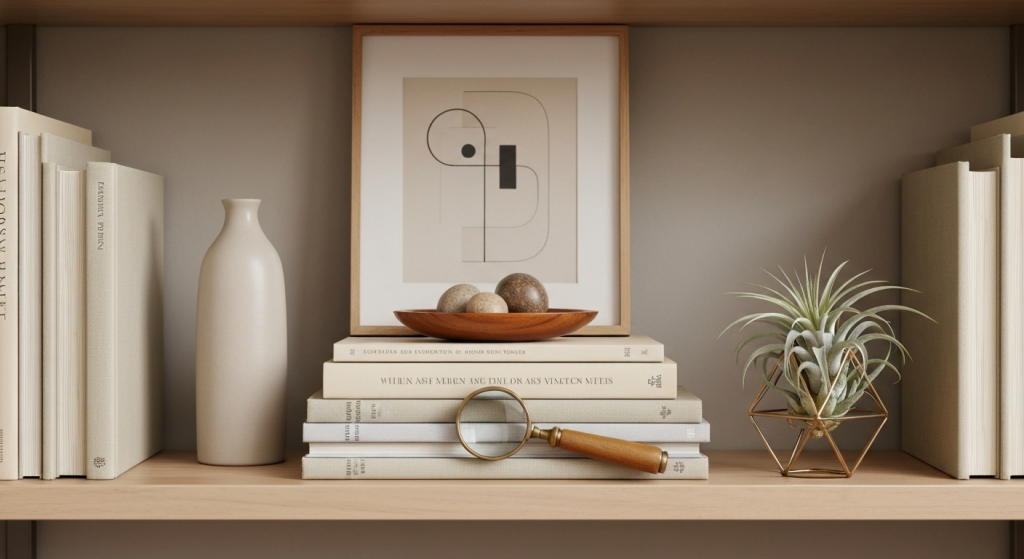
This is where you inject your personality. A bookshelf with only books can feel a bit heavy and academic. Interspersing personal and decorative objects breaks up the density and tells a richer story about who you are.
The Rule of Odds: Why Groups of 3 or 5 Work Best
A fundamental principle in design is that objects arranged in odd numbers are more appealing and memorable than those in even-numbered groups. Our brains process them as a single, more dynamic arrangement.
When placing decor, think in triangles. For example, on a horizontal stack of books, you might place a small vase, a decorative stone, and a tiny framed picture. Their different heights and shapes form a visual triangle that is naturally pleasing to the eye. Avoid placing two objects of the same height right next to each other; it creates a static, boring look.
Layering for Depth: Don’t Just Line Things Up
One of the biggest mistakes I see is placing everything in a single, flat line against the back of the bookshelf. To create a professional, curated look, you need to create depth.
- Back Layer: Start with taller, flatter items. This could be a piece of framed art, a decorative plate on a stand, or even a beautiful coffee table book displayed with its cover facing out. Lean it against the back of the shelf.
- Mid Layer: Place your books (both vertical and horizontal stacks) in front of this backdrop.
- Front Layer: Add your smallest objects here. This could be a small bowl, a candle, or a personal memento placed in front of the books or on a horizontal stack.
This layering technique makes the shelf feel lush and thoughtfully assembled rather than just a storage unit.
Choosing the Right Accents for Your Style
The objects you choose should complement your books, not compete with them. Look for items with varying shapes, textures, and materials.
- Natural Elements: Small potted plants (succulents and air plants are great low-maintenance options), seashells, interesting rocks, or a piece of driftwood add life and organic texture.
- Metallics: A small brass animal, a silver photo frame, or a copper vase can add a touch of shine and sophistication. It catches the light and draws the eye.
- Ceramics and Glass: Vases, bowls, and pottery add shape and color. You can use an empty, sculptural vase as an art object itself.
- Personal Items: Don’t be afraid to add things that are uniquely you. This could be a vintage camera, a souvenir from a trip, or a framed photo of loved ones. These are the items that make the shelf truly personal.
Here’s a quick guide to matching materials with common decor styles:
| Decor Style | Recommended Object Materials |
| Modern/Minimalist | Sleek metals (chrome, black matte), clear glass, simple white ceramics, abstract sculptures. |
| Farmhouse/Rustic | Distressed wood, galvanized metal, terracotta pots, woven baskets, antique-style pottery. |
| Bohemian/Eclectic | Macrame plant hangers, colorful patterned vases, natural wood, brass or gold accents, personal travel finds. |
| Traditional | Polished silver frames, porcelain ginger jars, classic busts, leather-bound boxes. |
The Power of Negative Space: Letting Your Shelf Breathe
This might be the most important—and most overlooked—element of styling. Negative space is the empty space around your books and objects. It’s not wasted space; it’s a crucial design tool.
Overcrowding a shelf is the fastest way to make it look cluttered, no matter how beautiful the individual items are. Leaving some areas empty gives the eye a place to rest. It allows you to appreciate the items you’ve chosen to display. If a shelf feels too busy, the first thing I do is remove one or two items. The difference is almost always immediate. Don’t feel the need to fill every single inch.
Balancing Beauty with Everyday Functionality
A bookshelf has to work for your life. If it’s so perfectly styled that you’re afraid to touch it, it’s not serving its purpose.
- Keep Favorites Accessible: Place the books you reach for most often on an easily accessible shelf, perhaps at eye level. Maybe don’t put your go-to cookbook on the top shelf behind a delicate vase.
- Hide the Unattractive: Every home has necessary clutter—remotes, charging cables, extra coasters. Use stylish decorative boxes or woven baskets to hide these items. Tucked onto a bottom shelf, a beautiful box can hold all your electronic clutter while looking like a deliberate design choice.
- Check Your Foundations: Before you start, make sure your bookshelf is sturdy and, if necessary, anchored to the wall, especially if you have children or pets. Distribute the weight of heavy hardcover books evenly, often placing them on the lower shelves.
Troubleshooting Common Styling Problems
Even with these guidelines, you might step back and feel like something is off. Here are some common issues and how to fix them.
| The Problem | The Likely Cause | The Solution |
| “It looks too cluttered and busy.” | Not enough negative space. Too many small, disconnected items. | Remove 2-3 items from each shelf. Group smaller items together (e.g., place three small stones in a decorative bowl). |
| “It feels flat and boring.” | Everything is the same height or lined up in a row. Lack of texture. | Create more horizontal stacks. Vary the heights of your decorative objects. Introduce new materials like metal, wood, or a plant. |
| “It looks too perfect and staged.” | It’s too symmetrical. It lacks personal touches. | Add something quirky or personal. A slightly askew book, a funny photo, or a handmade object can add warmth and personality. |
| “The colors feel chaotic.” | Too many competing colors without a clear palette. | Pick a color palette of 2-3 accent colors and repeat them with your objects across different shelves. This creates a cohesive flow. |
Frequently Asked Questions
How often should I restyle my bookshelf?
There’s no set rule. I recommend a light dusting and tidying every month, but a full restyle is only necessary when you feel it’s getting cluttered again or you simply want a fresh look for a new season.
Can I style a bookshelf without many books?
Absolutely! A bookshelf with fewer books gives you more room for larger decorative objects. Treat it more like a display case. Use larger vases, sculptures, or even a small table lamp to fill the space.
What’s the best way to light a bookshelf?
If your bookshelf doesn’t get much natural light, consider adding a picture light mounted above the top shelf. You can also use small, battery-operated LED puck lights placed discreetly inside the shelves to highlight certain objects.
How do I keep my styled bookshelf from getting dusty?
Regular dusting is key. Having fewer, more intentionally placed items actually makes dusting easier than on a cluttered shelf. For a deeper clean, remove everything once or twice a year and wipe down the surfaces completely.
Conclusion: Your Shelf, Your Story
Styling a bookshelf is a creative process that should be fun, not frustrating. Think of it as painting a three-dimensional picture where you get to be the artist. The goal is not to replicate a photo from a magazine, but to create a display that reflects your tastes, your passions, and your life.
Start with the great edit, build a foundation with your books, and then layer in the objects that make you smile. Don’t be afraid to experiment, move things around, and live with it for a few days before making final decisions. Ultimately, a well-styled bookshelf strikes the perfect balance between a beautiful, organized display and a functional, accessible part of your home. It’s your personal story, told one shelf at a time.
